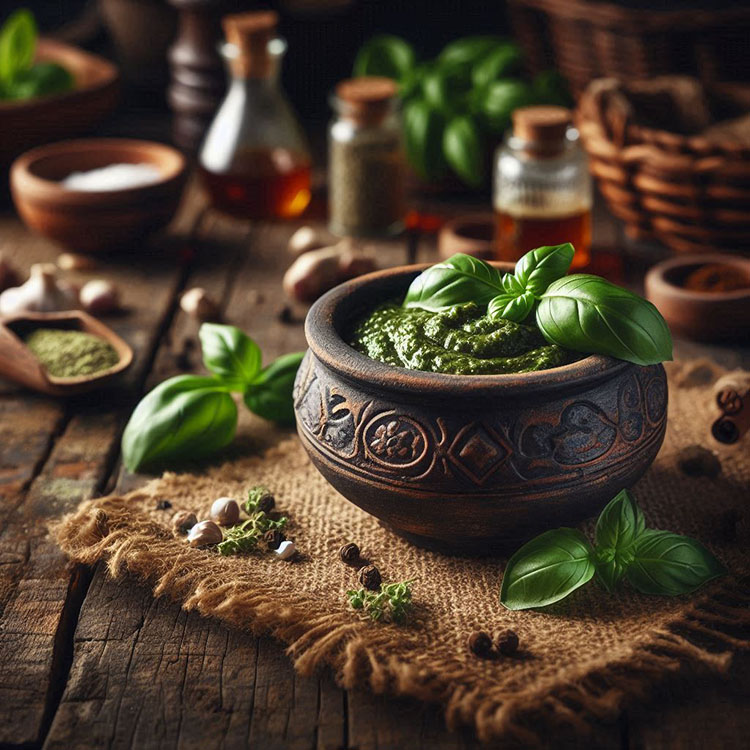
COMMON NAMES: Sweet basil, common basil, Saint Joseph’s Wort
FAMILY: Lamiaceae (mint family)
PARTS USED: All aerial parts (stems, leaves, and flowers)
WHERE FOUND: Native to India, basilic was exported for culinary purposes and essential oil production to Africa, and then to Europe. It is now widely cultivated throughout Europe, the Mediterranean region, the Pacific Islands, North and South America.
MEDICINAL PROPERTIES: Antimicrobial, antiviral, anti-inflammatory, antioxidant, carminative, adaptogenic, digestive, expectorant.
CHEMICAL COMPOSITION
1. Essential Oils (0.3–0.8% in fresh leaves)
Basil is rich in essential oils, which give it its characteristic fragrance and therapeutic benefits. The main components include:
Linalool: Floral aroma; calming, antimicrobial.
Eugenol: Gives a clove-like scent; anti-inflammatory, antiseptic.
Methyl Chavicol (Estragole): Sweet, anise-like scent; aromatic, digestive.
Cineole (Eucalyptol): Known for its cooling effect;
expectorant, respiratory support.
Camphor: Offers a fresh, medicinal scent; stimulating and antiseptic.
2. Phenolic Compounds and Flavonoids
Basil contains numerous antioxidants that protect cells from oxidative stress:
Rosmarinic Acid: A potent antioxidant with anti-inflammatory effects.
Caffeic Acid: Supports immune function and has antioxidant properties.
Apigenin, Luteolin, and Quercetin: Flavonoids with anti-cancer and anti-inflammatory properties.
3. Vitamins and Minerals
Vitamin K: Important for blood clotting and bone health.
Vitamin A: Supports eye health and immune function.
Vitamin C: Provides antioxidant protection.
Calcium, Magnesium, and Iron: Contribute to bone health, muscle function, and oxygen transport.
4. Other Compounds
Tannins: Possess antimicrobial and astringent properties.
Saponins: May support immune health and reduce cholesterol.
Beta-Caryophyllene: Acts as an anti-inflammatory agent and supports pain relief.
The exact composition of basil constituents can vary depending on the variety (e.g., sweet basil, Thai basil, or holy basil), growing conditions, and harvesting time.
TRADITIONAL USE
For medicinal purposes, basil leaves are harvested before the plant begins to flower. They can be used fresh, dried, preserved in vegetable oil, or stored frozen. Dried basil typically has a shelf life of up to two years. In folk medicine, basil has been widely valued for its therapeutic properties, with the purple variety often considered more potent.
1. Respiratory Health
- Basil leaves are often used to treat respiratory conditions like coughs, asthma, bronchitis, and whooping cough.
- Infusions or teas made from basil are believed to help relieve chest congestion and soothe sore throats.
- Inhaling steam infused with basil leaves can ease nasal congestion.
2. Digestive Support
- Basil is used as a natural remedy for indigestion, bloating, and gas.
- It has carminative properties, meaning it helps reduce gas formation and supports healthy digestion.
- Basil tea is often consumed to relieve stomach cramps and nausea.
3. Urinary Tract Health
- In cases of cystitis (bladder inflammation) and pyelitis (kidney inflammation), basil is used to alleviate symptoms such as painful urination.
- It may also serve as a mild diuretic, promoting urination and flushing out toxins.
4. Pain and Inflammation Relief
- Fresh basil leaves are applied as a poultice to treat joint pain, rheumatism, and arthritis.
- Basil oil or leaf extracts are sometimes used to reduce headaches and migraines when applied to the temples.
5. Skin and Wound Healing
- The antibacterial properties of basil juice or paste are used to clean and disinfect wounds, cuts, and ulcers.
- It can also be applied to treat skin infections and acne, cracked nipples and heels.
6. Ear and Eye Care
- Fresh basil juice is sometimes used as a natural remedy for middle ear infections with pus formation.
- A seed infusion is applied as a compress for eye inflammations or conjunctivitis.
7. Stress and Anxiety Management
- Basil, particularly Holy Basil (Tulsi), is considered an adaptogen in Ayurvedic medicine, meaning it helps the body cope with stress.
- Consuming basil tea or leaves may promote mental relaxation and improve mood.
8. Women’s Health
- Basil is used to regulate menstrual cycles and relieve symptoms of amenorrhea (absence of menstruation).
- It may also reduce menstrual cramps and discomfort.
9. Antipyretic Effect
- In some cultures, basil is used as a remedy to reduce fever by promoting sweating and cooling the body.
CONTRAINDICATIONS
Excessively high doses of basil can have a strong irritating effect on the body. The following are cases where higher doses of basil (medicinal strength) are not recommended:
Heart Conditions: Due to its hypercoagulant effect, basil is contraindicated for individuals with heart diseases, a history of myocardial infarction, thrombophlebitis, or thrombosis.
Hypertension and Diabetes.
Neurological Disorders: Basil is not recommended in cases of inflammatory processes of the brain.
Pregnancy and Lactation.
Children under 14 years old.

SWEET BASIL ESSENTIAL OIL PROPERTIES
There are many varieties of basil, but essential oils are primarily obtained from two plant phenotypes: exotic basil and sweet basil. Both types share the same botanical name, but their essential oils differ in chemical composition, properties, and effects on the human body. When purchasing basil essential oil, it is essential to specify which variety it is derived from.
Essential oil obtained from exotic basil is not recommended for therapeutic use due to its high content of estragole (70-88%), which may be harmful if used in large quantities.
AROMATHERAPY USE
Skin Care: Helpful for insect bites (e.g., mosquito, wasp) and as a natural insect repellent. Soothes burning, itching, and swelling after bites.
Circulation, Muscles & Joints: Eases muscular aches and pains, including those associated with gout, rheumatism, and arthritis.
Respiratory System: Supports relief from bronchitis, coughs, asthma, and earaches. Assists in clearing runny noses, sinusitis, sinus infections, and frontal sinus inflammation.
Digestive System: Aids with indigestion, flatulence, nausea, vomiting, and gastrointestinal spasms.
Genito-Urinary System: May relieve cramps and support scanty or delayed menstruation.
Immune System: Useful in managing colds, fever, flu, and various infections.
Nervous System: Known to reduce anxiety, depression, fatigue, insomnia, headaches, migraines, vascular spasms, dizziness, and general nervous tension
METHODS OF USE
Aroma Lamp: Add 3-7 drops per 15 square meters of space.
Hot Inhalations: Use 1-2 drops for 4-5 minutes.
Cold Inhalations: Use 1-2 drops for 3-5 minutes.
Baths: Add 4-7 drops to the bathwater. Do not use continuously for more than 21 days.
Aroma Pendant: Apply 2-3 drops to an aroma pendant for a lasting fragrance.
Internal Use: Take 1 drop 2-3 times a day with honey, followed by linden tea. (Only under supervision from a healthcare provider).
Compatibility Enhancement: Basil essential oil’s effectiveness increases 20 times when combined with coriander, lavender, or especially eucalyptus oils.
Avoid Combination: Do not mix basil with monarda oil, as it reduces the antibacterial activity of both oils by 50%.
Complementary Oil: Ginger is a great complementary oil, enhancing basil’s therapeutic effects.

COSMETIC USE AND BEAUTY RECIPES
Basil essential oil is valued in cosmetics for its rejuvenating and antioxidant properties, making it a popular ingredient in anti-aging and lifting formulations. It enhances hair shine, stimulates growth, and helps improve hair structure. In skincare, it is used for both the body and delicate eyelid areas. Recommended usage concentrations in cosmetic products range from 0.1% to 1%.
Basil hydrosol (floral water) is suitable for all skin and hair types, with particular benefits for mature or aging skin. It tones, regenerates, softens, and promotes healing, while also offering antiseptic and anti-inflammatory effects. It can be used in cosmetic formulations at concentrations of up to 100%.
Rejuvenating Face Mask:
Mix 1 teaspoon of honey, 1 egg yolk, and 2-3 drops of sweet basil essential oil. Apply the mixture to the face and leave for 10 minutes. Rinse off with warm water.
Hair Shine Rinse:
Pour 1 liter of boiling water over 2 tablespoons of crushed basil leaves. Let it infuse for 1 hour, then strain. Use as a final rinse after washing your hair.
Body Tonic:
Crush fresh basil leaves into a paste. Pour 1 cup of boiling water over 3-4 tablespoons of the paste. Let it steep for 30 minutes, then strain. Apply to the body after a shower, bath, or sauna, or use as a rinse.
Basil Juice for Acne:
Apply fresh basil juice directly to pimples and affected areas 3-4 times a day to speed up healing.
Strengthening & Shine Hair Rinse:
Mix 1 tablespoon of crushed basil leaves and 1 tablespoon of crushed rosemary. Pour 1 liter of boiling water over the herbs, let it infuse for 1 hour, then strain. Use as a hair rinse after every wash. This rinse can be used long-term, with both fresh and dried herbs.
Tags:
Leave a Reply